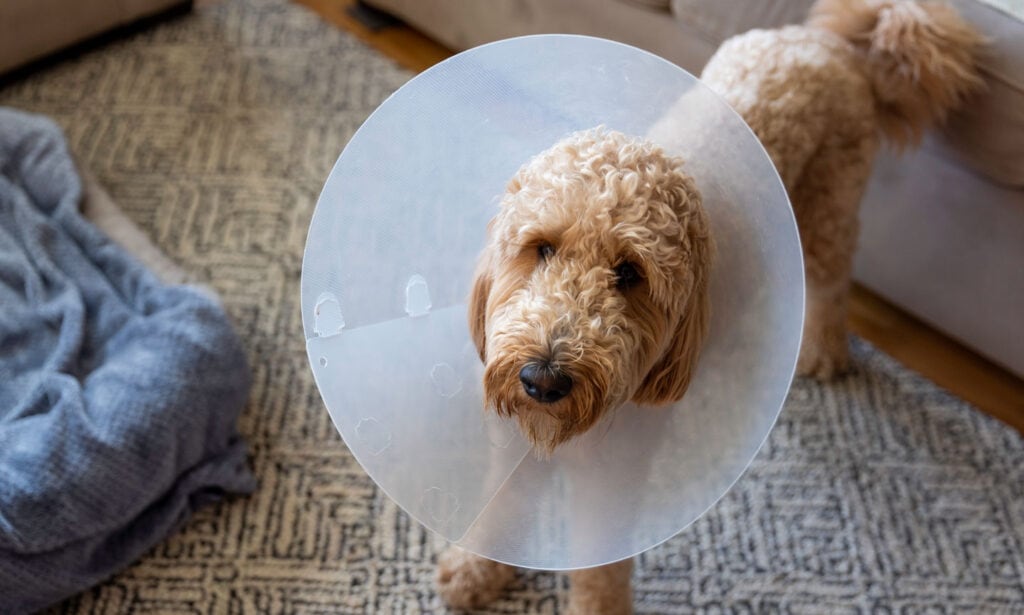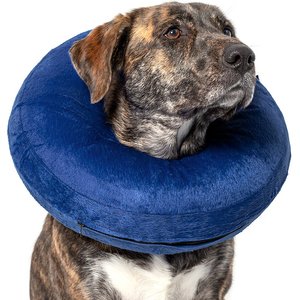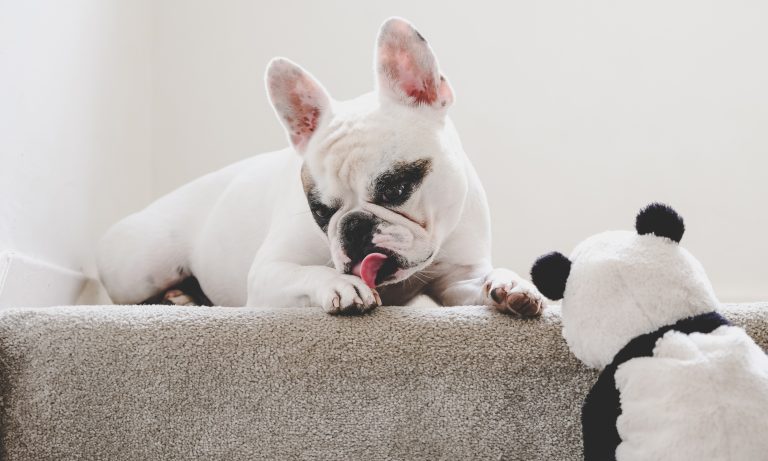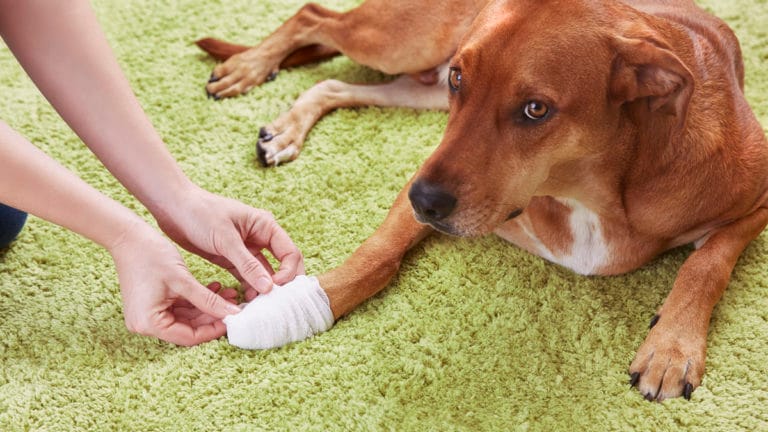It's the phrase pet parents dread hearing from their veterinarian: "Your dog needs to wear a cone..." Many people refer to recovery cones as the “cone of shame” because pets often need them when they are licking or chewing at their wounds or surgical incisions. These lampshade-style dog cones are a crucial tool used to help pets’ healing and recovery after surgery or an injury.
However, the lack of peripheral vision can make it difficult for your dog to navigate around the house, and they don’t always love wearing them. The good news is that it’s only temporary, but how can you make your dog's cone couture less frustrating? We have tips and alternatives to make recovery collars a better experience for pup and pet parent alike.
What Is a Dog Cone?
Traditional dog cones are also called Elizabethan collars, or e-collars for short, because they look like the (somewhat ridiculous) high-necked collars called ruffs that people wore back in Elizabethan times.
Today’s stiff plastic protective barriers wrap around your dog's neck and extend past their nose to prevent licking or scratching at an injury or surgical site. Most dogs need to wear a cone at least once in their lifetime, after spay or neuter surgery, or perhaps to allow a hot spot to heal properly.
Even though your dog may protest wearing a cone, if you don’t use it or take it off too soon, you could quickly have an expensive and devastating disaster. These cones are for the pet’s safety, benefit and recovery.
"The pet ends up chewing on the wound or ripping out their sutures,” says Lori M. Teller, DVM, a clinical professor at Texas A&M University in College Station, Texas, and immediate past president of the American Veterinary Medical Association.
If this happens, you and your dog could end up making another trip to the animal hospital.
“It could potentially be an emergency visit, depending on the severity of the damage,” Dr. Teller says. “The pet may need to be anesthetized again and have an extensive wound repair.”
3 Dog Cone Alternatives
If your dog struggles in a traditional plastic cone, there are cone alternatives to try, like soft cones, inflatable cones or recovery clothing. Similar to traditional cones, they come in various sizes to fit your dog and can be less obtrusive. “They don't inhibit vision as much, they don't amplify sound, and they tend to be much more comfortable," Dr. Teller says.
If you opt for a cone alternative, be sure to:
- Strictly supervise your dog to ensure they can’t remove it.
- Make sure it’s large enough so your dog can't reach, lick or scratch the area that needs to heal.
- Check with your veterinarian to make sure it is an appropriate alternative for your pet and their specific concern.
Soft Cone
A soft cone looks and works similarly to plastic traditional cones, but are usually made from mesh, cotton or foam. They’re flexible and often use Velcro closures, which may make soft cones easier to adjust, put on and remove than plastic cones. Some have soft plastic or clear inserts that give your dog more peripheral vision. Dr. Teller says soft cones can be less jarring if your dog runs into the wall, furniture or your leg.
Inflatable Cone
An inflatable cone is a donut-shaped ring that looks like a neck pillow you use on airline flights. You slip the protective inflatable collar over your dog’s head and fasten the Velcro shut for a custom fit.
Most inflatables are covered in fabric, so they’re definitely a comfy cone option. But since your dog’s head is exposed in an inflatable cone, make sure they can’t access the surgical site or injury with their mouth or paws. Dr. Teller says some dogs have been known to use their back leg to slip the inflatable collar right off their neck.
Recovery Clothing
Recovery clothing options are a total cone alternative. They’re sort of like jammies or body suits that cover the surgical site or wound so your dog can’t lick or scratch at it. “It’s a great alternative to cones for some dogs,” Dr. Teller says.
Typically, you pull them over your dog’s body and snap or Velcro shut.
The recovery suits and shirts come in different sizes and are usually machine washable. Another pet recovery clothing choice is lick sleeves. You simply slide the sleeve over your dog’s paw and onto their leg to protect injuries or incisions. Always be sure your pet is supervised so they do not chew or ingest any clothing or material.
Talk to Your Veterinarian
Since cones are vital to the healing process, talk to your veterinarian about the best dog cone option for your pup.
Regardless of the type of cone or alternative you are using, if your pet escapes from it and is able to lick or chew their wound or incision, this may be an emergency. Reach out to your vet immediately as a recheck or additional medication (such as antibiotics, pain meds or sedatives) may be needed. "It may very well be that your pet may need some kind of medication to decrease their anxiety and provide a bit of sedation until it's safe to take the cone off," Dr. Teller says. Medications like this can help a pet tolerate the cone or alternative.
How To Find the Best Dog Recovery Collar for Your Pup
To figure out the best pet care recovery collar option, consider the following factors and chat with your veterinarian.
- Is your dog a known cone or cone alternative escape artist? Some dogs can break out or chew through every type of cone out there. If your dog has a strong dislike of cones or alternatives, ask your veterinarian about using some sedating medication during their cone time.
- What area are you trying to protect? Evaluate the part of your dog's body you're trying to limit access to. "Recovery suits are not going to help if you have something on a tail or on a foot," Dr. Teller says. "In those instances, you may be looking at a plastic cone, a soft cone or an inflatable collar." Check with your vet to ensure the cone or alternative you have suggested is appropriate for your pet’s concern.
- What is your dog's age and temperament? If your dog is a senior couch potato, they may be a perfect patient for and be just fine with a comfy cone. But if they're the "I love zoomies" kind of puppy, you'll likely need a sturdy recovery collar and possibly some mellowing medicine.
- What is your dog's size? Traditional cones and cone alternatives come in many shapes and sizes. Before you order a cone online, follow the website’s neck and body measurement directions closely, so you have a precise fit. Don’t just guess the collar will fit small dogs, for example.
- Is your dog a determined licker? Ensure any cone or cone alternative prevents your dog from being able to lick the injured area. If your pup is trying to lick the wound because they're itchy or in pain, call your veterinarian immediately to discuss ways to address that.
How To Put On a Dog Cone
What’s the easiest way to put a cone on your dog? Dr. Teller says if your dog had a procedure at an animal hospital, ask your veterinarian or the staff to help.
If you’re on your own, Dr. Teller shares her insider tips:
- Measure the circumference of your dog’s neck and choose a recovery cone slightly larger.
- Make sure the length of the cone will extend past your dog’s nose.
- Assemble the cone according to the instructions.
- Show your dog the cone and give them their favorite snack.
- Use treats to reward your dog as you slip the cone over their head.
- Fasten the collar using the attached fasteners (usually Velcro or snaps) and/or buckle your dog’s collar.
- Check the fit. You should be able to fit two fingers between the cone and your dog’s neck.
- Confirm that your dog can breathe comfortably. Adjust the fit as needed.
It's normal for your dog to take time to get used to the cone. Continue to praise your dog and give treats so they associate the cone with their favorite goodies.
Dog Cone FAQ
Q:
When should I put a cone on my dog?
A:
Put a cone on your dog if your veterinarian recommends it.
Even though your pooch may protest wearing one, if you don't use a pet cone or take it off too soon, your dog could pull out their sutures or rip open a wound after surgery—and you could end up in the emergency room with a hefty bill.
If your dog has a chronic condition—like a hot spot, allergies or recurring eye infections—and you can't immediately see your veterinarian, using a pet cone to keep your dog from licking or scratching the area and making it worse can be helpful.
Q:
Can I leave my dog in a cone all day?
A:
While your dog might not be happy about this answer, you can leave your dog in a cone all day. The cone will prevent your dog from licking, chewing or scratching at an area of their body that needs to heal.
“If you need to, you can take the cone off when the dog is eating and drinking water, but that needs to be done under full supervision,” Dr. Teller says.
Q:
Can dogs sleep with a cone on?
A:
Your dog can and should sleep with a cone on. You should only take off the cone if you can closely monitor your dog.
“Dogs are notorious—when everyone else has gone to sleep, they wake up, and maybe their wound is a little bit itchy, and they will start licking at it,” Dr. Teller says. “Of course, people are asleep and can’t do anything to stop the dog.”
Q:
Will a cone stop my dog from licking?
A:
A cone can help stop your dog from licking a wound that needs to heal on their body. The pet cone should be large enough to physically block your dog from accessing the affected area.
But a cone will not decrease your dog's need or desire to lick, so if there are underlying allergies, pain or irritation, talk to your veterinarian about addressing those issues.
Dog Cones Prevent Catastrophes
Though cones can be annoying for both you and your dog, they’ll help you prevent a temporary medical condition from turning into a catastrophe. Your best resource is your veterinarian to discuss your dog’s needs.
Is your dog about to have spay surgery? Learn all about the dog spaying procedure from start to finish.
Expert input provided by Dr. Lori Teller, DVM, a clinical professor at Texas A&M University in College Station, Texas, and immediate past president of the American Veterinary Medical Association.
This content was medically reviewed by a veterinarian.
Read more about situations in which your dog may need to wear a cone:
Share:



















